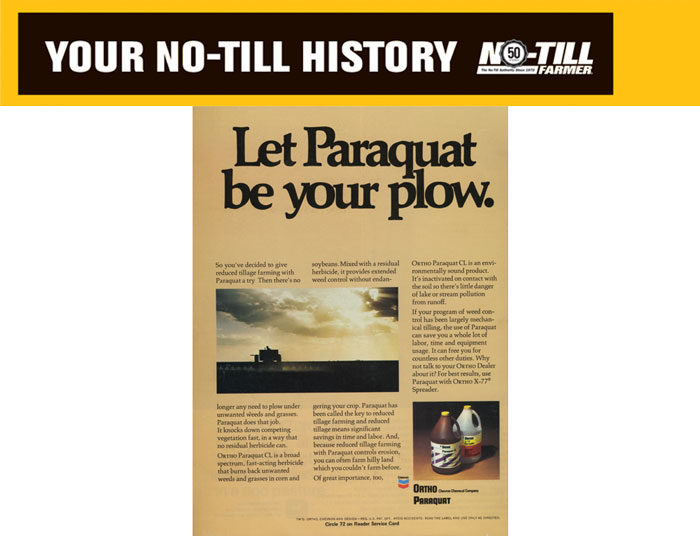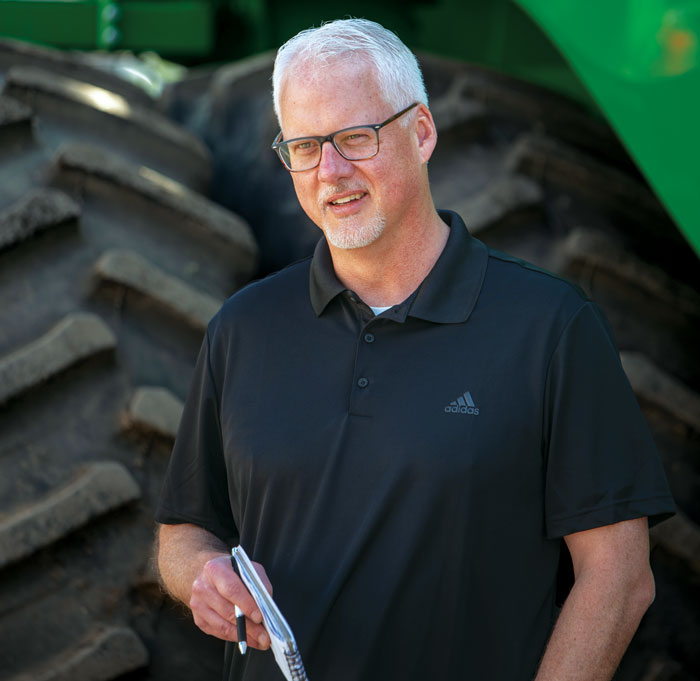When No-Till Farmer (NTF) got its start in 1972, its pages were filled with tips on how to make herbicides like paraquat, atrazine, 2,4-D, Princep and Banvel (an early dicamba formulation) work in no-till systems. In Part 1 of this series, we’ll look at the most important early herbicides for no-tillers.
2,4-D
Dow Chemical set things in motion for weed control with its 1946 release of 2,4-D. This development allowed farmers to dream of cultivating without tillage. It killed broadleaf weeds by causing the cells that carry water and nutrients to divide and grow without stopping, or as retired University of Nebraska professor Alex Martin puts it, getting the weed “to grow itself to death.”
According to Farming the 1940s by Bill Ganzel, 2,4-D — the first widely used selective chemical herbicide — changed ag history. “For the first time, farmers had a chemical that they could spray on their corn fields that would kill more weeds than any amount of cultivating.”
In 1947, Nebraska Farmer reported on Carl Leonard, one of America’s first farmers to try 2,4-D. “Leonard’s 240 acres of weed-treated corn yielded 50 bushels to the acre,” reported the magazine. “An unsprayed field produced nubbins.” A control field was cultivated with standard equipment 3 times and yielded 56.8 bushels per acre while another field sprayed once with 2,4-D yielded 63.1 bushels per acre. Another field sprayed 3 times yielded 84.5 bushels per acre.
Atrazine
Ciba-Geigy developed atrazine and registered its use in 1958 to control weeds in corn. Since the early 1960s, the inexpensive herbicide has been used extensively in the U.S. Atrazine interferes with photosynthesis in some broadleaf plants and grasses, causing weeds to dry out and die.
“It was the first residual post-emergence herbicide that you could apply to the soil to control a weed before the weed germinated,” said Martin. “Atrazine became the most widely used herbicide across the Corn Belt shortly thereafter through the 1960s and into the mid-1990s.”
“The impact atrazine has in weed control and making no-till production possible is as vital today as it was over 50 years ago when the product was brought to market,” said Kentucky Corn Growers Association Executive Director Laura Knoth in 2019.
Both are still in use today by no-till corn growers: 2,4-D by 35% and atrazine by 64%, according to the 2022 NTF Operational Benchmarking Survey.
Anti-Chemical = Unintended Consequences
“There’s a tradeoff in everything we do. In farming, you can only practice one method at a time on any location. It’s important that we understand that if you till the soil, you’ll lose the soil. It was proven before there was no-tillage, and it’s still the case. No-tillage is the best thing I know of — at the moment. It may not be perfect, but it’s the best thing I know to keep the soil where it belongs — right here on the family farm.” —John Young, who no-tilled his Kentucky cropland for the 60th consecutive season in 2022
Chemophobes and environmentalists should be careful what they wish for. Get rid of synthetic farm chemicals and the result will be more tillage, more dead soils, more soil erosion and more CO2 (from black-turned soils and more frequent use of larger, diesel-powered tractors). More poverty and world hunger wouldn’t be far behind if some activists got their way.
The success of no-till, its healthy and diverse soils, and herbicides for production-volume agriculture are linked in a way that is rarely recognized by “Joe Public.” Use the online commenting tool to share how you state your position.
Web Extras: See “Tillage vs. Herbicides: The Science is Clear” by Julia Gerlach at no-tillfarmer.com/debate
Paraquat
If 2,4-D and atrazine cleared the way for no-till, you could say paraquat burned the trail. Invented in the U.K. in 1955, Imperial Chemical (ICI) licensed the formulation to Chevron Chemical Co. By the early 1960s, paraquat (or gramoxone) was used to control the weeds around U.S. orchard trees and beside oil tanks, buildings and railroad right of ways.
California-based Chevron Chemical discovered a new market after noticing large volumes of paraquat shipments into Kentucky, an odd region for an orchard-related product. A Chevron marketing manager attending a New York conference was told to add a day onto his trip to take a look before flying home. What he saw in Western Kentucky caused him to delay his flight home by a few more days.
An ag retailer took him out to the farm of Harry and Larry Young in Herndon, Ky., (the first-ever commercial no-tillers in 1962). The brothers had hit on the idea of using paraquat as a burndown contact herbicide to control anything growing prior to no-tilling their corn and soybeans.
This chance encounter led to Chevron and ICI soon becoming major players in no-till. They started working toward a paraquat herbicide label for no-tilled corn along full-season and double-cropped soybeans.
Paraquat inhibited photosynthesis on a wide range of annual grasses and broadleaf weeds, and on the tips of perennial weeds. Further, it was fast-acting, rain-fast within minutes and was partially inactivated upon contact with the soil. These benefits, as cited in two mid-1960s research works on “plow-less agriculture,” led to paraquat’s key role in the development of no-till farming.
While its use has declined significantly, paraquat is getting new looks again from no-tillers as they seek solutions for glyphosate-resistant weeds.
Next Month: No-Till & The Roundup Rally
For additional reading, see:
The 2024 No-Till History Series is supported by Calmer Corn Heads. For more historical content, including video and multimedia, visit No-TillFarmer.com/HistorySeries.








Post a comment
Report Abusive Comment